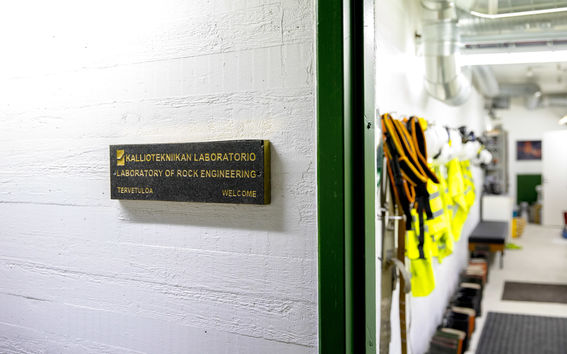GeoCorner

When
Where
Event language(s)
Programme 21.11.2025
The length of each presentation is 15 minutes, with an additional 5 minutes reserved for discussion.
- 14.00-14.20: Lucas Tan
- 14.20-14.40: Muftaudeen Toyin Saheed
- 14.40-15.00: Joshua Tumwine
- 15.00-15.20: Kaisla Kivistö
- 15.20-15.40: Khaoula Kaissi
- 15.40-16.00: Stephen Okutu-Ayiku
- 16.00-16.20: Yunlong Zhu
- 16.20-16.40: Peter Kolis
Prof. Wojciech Solowski, Director of the Master's Programme in Geoengineering

Leena Korkiala Tanttu

Theses presented
Author: Lucas Tan
Supervisor:
Advisor(s):
Funding:
Abstract:
Author: Muftaudeen Toyin Saheed
Supervisor: Prof. Mohammed Noureldin
Advisor(s): NA
Funding: NA
Abstract: The increasing urgency to reduce carbon emissions in the built environment has intensified interest in evaluating how structural design standards influence material efficiency, economic cost, and environmental performance. This thesis presents a comparative evaluation of reinforced concrete (RC) frame design using the provisions of Eurocode 2 (EC2) and the American Concrete Institute (ACI 318-19), with a focus on structural performance, economic, and sustainability outcomes. A two-storey, two-bay RC frame was modelled and designed in DLUBAL RFEM 6.0, using each code independently, to generate total steel reinforcement quantities. For this study, the concrete volume for each element (Slab, beam, and column) remained the same in both designs. Based on the design outcome, the steel reinforcement requirements showed modest differences: EC 2 required slightly more steel in beams, while ACI re-quired more reinforcement in both slabs and columns. To interpret the practical implications of these material differences, the study integrated Life Cycle Assessment (LCA) and Life Cycle Costing (LCC). Two decision-oriented scenarios were developed. Scenario 1 used identical embodied carbon factors and unit material costs, providing a controlled comparison that isolates the influence of design standards. Scenario 2 assigned region-specific factors representing typical conditions in the European Union (EU) and the United States (US), allowing assessment of how regional material factors affect environmental and economic performance. Based on Scenario 1, the sustainability out-comes of EC2 and ACI were nearly identical. Embodied carbon differed by ap-proximately 2%, and total material cost by 1.2%, indicating that, for this structural configuration under study, the choice of design code has minimal impact on whole-structure sustainability when material factors are held constant. However, Scenario 2 revealed that regional material characteristics exert a far more substantial influence. Applying US-based material data increased embodied carbon by approximately 67% and costs by 19% relative to the EU scenario. This disparity, especially in the embodied carbon, stemmed mainly from the higher carbon intensity of US concrete production, underscoring the pre-dominance of supply-chain effects over code-driven design difference.
Title: Sustainable Utilisation of Biochar in Asphalt
Author: Tumwine Joshua
Supervisor: Assistant Professor Sanandam Bordoloi
Advisor(s): Bhaskar Das (Phd)
Funding: non
Abstract
In recent times, there has been an increase in demand for alternative sustainable environmentally friendly asphalt paving materials. In this thesis, the study is carried out to assess the potential of utilising biochar, a carbon rich material obtained by the process of pyrolysis of biomass, to modify bitumen binder as well as potentially act as a partial asphalt binder replacement. This is especially of significant importance because of the large amounts of waste streams from various sectors (including agricultural and forestry) that end up in land-fills while others remain unmanaged biomass-waste posing environmental challenges. This study assesses and characterises; the rheological, chemical, physical, and microscopic morphology performance aspects of bituminous asphalt binder amended with biochar.
In this study, biochar weight proportions of 5%, 10%, 15% were added into a bitumen binder of penetration grading 50/70. Laboratory assessments including softening point testing, penetration testing, Fourier Transform Infrared Spectroscopy (FTIR), Thermo-Gravimetric Analysis (TGA), Differential Scanning Calorimetry (DSC), Scanning Electron Microscopy (SEM) were conducted to evaluate the effects (including consistency, chemical composition, thermal structure) of biochar on bitumen binder.
With addition of biochar from 0-15%, bitumen binder portrayed a gradual decrease in the penetration reaching a maximum 30% decrease in penetration at 15% biochar content.
On the other hand, the softening point increased by a 5% relative to the control binder sample.
With Biochar behaving in form of a rigid, high-surface area filler that fosters a particle-binder network enhancing stiffness. This high surface area honeycomb-like porous structure likewise enables the modified binder to portray some improvement in the aging resistance because of the ability to absorb light components and delay oxidation of asphalt.
Also, the study shows that incorporation of biochar into bitumen binder enhances the high temperature rutting resistance of the bituminous asphalt binder. But high-level proportions of biochar of more than 10% can induce higher stiffness levels and high viscous nature resulting in that inhibit workability. In this study, the optimal results are achieved at biochar proportion of 10%.
Työn otsikko/Topic of the thesis:
Paalutuskohteen työalustan laskennallinen mitoittaminen ja laadunvalvonta työmaaolosuhteissa
Analytical design and in-situ testing of a working platform for a piling site
Tekijä/Author:
Kaisla Kivistö
Valvoja/Supervisor:
Professori Jussi Leveinen
Prof. Jussi Leveinen
Ohjaaja(t)/Advisor(s):
DI Kimmo Tanttu ja DI Mikko Riikonen
MSc. Kimmo Tanttu and MSc. Mikko Riikonen
Rahoitus/Funding:
Suomen geoteknillinen yhdistys ry, Väylävirasto, Betoniteollisuus ry, GeoPro Consulting Oy
Finnish geotechnical society, Finnish transport infrastructure agency, Betoniteollisuus ry, GeoPro Consulting Oy
Tiivistelmä:
Paalutustyötä tehdään tavallisesti heikoissa pohjaolosuhteissa, joten paalutuskohteeseen on suunniteltava ja toteutettava työalusta, jonka päällä paalutuskalusto voi työskennellä turvallisesti ja tehokkaasti. Paalutustyöalusta on tavallisesti tiivistetystä murskeesta tehty maanvarainen pohjarakenne. Työalustojen mitoittamiseen ei ole olemassa standardia Suomessa tai muualla maailmassa, eikä siitä, miten työalustat tulisi mitoittaa, ole päästy yksimielisyyteen.
Tämän diplomityön tavoitteena oli tutustua vaihtoehtoisiin paalutustyöalustojen mitoitusmenetelmiin sekä työalustojen laadunvalvontaan. Kirjallisuuskatsauksen lisäksi työssä tarkasteltiin laskennallisesti työalustojen mitoittamista eri paalutuskalustoille vaihtelevissa pohjaolosuhteissa. Tarkasteltavat laskentamenetelmät olivat BR 470, TWf 2019, T-arvomenetelmä sekä toisen sukupolven eurokoodin SFS-EN 1997-3:2025 kantavuuskaava B.6. Lisäksi tehtiin vertailulaskelmia stabiliteettitarkasteluna.
Laskelmissa käytettiin paalutuskoneesta aiheutuvana kuormana standardin SFS-EN 16228-1 mukaista kriittisimmän kuormitustilanteen telapainetta, jota tulee käyttää eurokoodien mukaisessa suunnittelussa. Laskentamenetelmät koostuvat pääosin suhteellisen yksinkertaisista laskukaavoista, kun taas paalutustyötä voidaan pitää varsin monimutkaisena kuormitustilanteena. Näin ollen menetelmiin sisältyy useita rajoituksia ja tarkastellut laskentamenetelmät johtivat varsin suuriin työalustojen paksuuksiin. Stabiliteettitarkastelulla saatiin tuloksena parhaiten nykykäytäntöjä vastaavia paalutustyöalustoja.
Työalustojen laadunvalvonnan tarkoituksena on varmistaa, että alusta on toteutettu suunnitelmien mukaisesti ja soveltuu tarkoitettuun paalutustyöhön. Laadunvalvonnassa keskeistä on varmistaa alustan riittävä kantavuus sekä tiiviys, mikä voidaan tehdä levykuormituskokeilla tai pudotuspainolaitteella tehdyillä mittauksilla. Näiden rajallisen vaikutussyvyyden vuoksi olisi suositeltavaa myös varmistaa esimerkiksi koekuopilla, että alustan todellinen paksuus vastaa suunnitelmia.
Abstarct:
|
Piling operations are typically carried out in weak ground conditions, which means that a working platform must be designed and constructed so that safe and efficient operation of piling equipment is enabled. A working platform is typically a ground-supported structure composed of compacted crushed aggregate. Currently, there is no standard either in Finland or internationally for designing working platforms and no consensus has been reached on how it should be carried out. The objective of this master’s thesis was to examine existing design methods for working platforms and explore practices to ensure their quality. In addition to literature review, the study included computational analyses of platform design for various types of piling rigs under differing ground conditions. The design methods investigated were BR 470, TWf 2019, T-value and the bearing capacity formula B.6 presented in the second-generation Eurocode SFS-EN 1997-3:2025. Also, comparative stability calculations were performed. In the calculations, the loads induced by the piling rigs were determined according to standard SFS-EN 16228-1, which must be used for Eurocode-based design. All the design methods are primarily based on relatively simple analytical expressions whereas piling work itself represents a rather complex loading situation. Consequently, the methods involve numerous limitations, and the resulting platform designs obtained were generally quite conservative. The stability analyses produced platform designs that most closely reflected current practical approaches. The purpose of in-situ testing of a working platform is to ensure that the platform has been constructed according to the design and is suitable for the intended piling work. The key aspects of quality control are verifying sufficient bearing capacity and compaction, which can be assessed using plate load tests or measurements with a falling weight deflectometer. Because of the limited depth of influence of these tests, it is recommended to verify, for example through trial pits, that the actual thickness of the platform corresponds to the design. |
Author: Khaoula Kaissi
Supervisor: Prof. Jussi Leveinen.
Advisor(s): Asst. Prof. Lauri Uotinen, Sr. Data Scientist. Matias Heino
Funding: Lumo Analytics Oy
Abstract:
|
Virtual Reality (VR) and Augmented Reality (AR) tools are rapidly gaining a place in the mining industry, from safety training and equipment simulations to mine designing and planning. Therefore, more companies are financing R&D projects to explore innovations such as VR and AR. The surging use of VR in the mining industry inspired this thesis project, with the aim of expanding its application to core logging. The objective was to make data available for geologists to visualize, interpret, and analyze remotely. This thesis describes, in detail, the complete workflow to build a virtual core tray that integrates analytical and visual data. Each core was modeled using two datasets: LIBS (Laser Induced Breakdown Spectroscopy) and RGB photogrammetry-based mesh. The study focuses on the Terrafame deposit’s archive drill core box to create a bridge between conventional core logging and VR. The workflow combines different tools and devices: LIBS data acquisition with Lumo Analytics LASOLIBS, data processing with Jupyter Lab, and mesh reconstruction in CloudCompare. The RGB models were acquired after high-resolution photogrammetry and model reconstruction using RealityScan. Both datasets, deriving from distinct sources and coordinate systems, were aligned, merged, and scaled with Blender to ensure spatial and visual accuracy. A total of 25 core models were combined in Unity to recreate the drill core box, forming the base of an interactive VR core logging scene designed for the Meta Quest 3 headset. Adapted C# scripts enable realistic interaction features such as rotating, scaling, zooming, and toggling between both meshes to visualize the mineral composition and study the surface texture. The results show that integrating different datasets, from different sources, within a VR environment requires a detailed structured workflow with precise settings and parameter control. Users’ feedback from live demonstrations showed that this vision has strong potential as an efficient tool for geological data visualization and education. While conventional core logging remains dominant, this work focuses on how immersive technologies can complement current methodologies in the future. |
| Author Okutu-Ayiku Stephen Adi |
| Thesis supervisor Prof. Mikael Rinne |
| Thesis advisor(s) Dr. Mateusz Janiszewski |
| Funding Not funded |
|
Abstract This study evaluates the potential of 3D Gaussian Splatting (3DGS) as a novel 3D digitization method for rock mass characterization. The main focus was on the relative accuracy of 3DGS, its efficiency, and visualization capabilities compared to the traditional photogrammetric methods and manual field method. Gaussian Splatting generally enables the creation of real-time, photo-realistic 3D reconstructions through a point-based rendering technique that blends both geometry and texture data. This research investigated optimal data acquisition and processing workflows, the influence of device capabilities (mobile versus desktop), and the applicability of 3DGS under challenging underground conditions. Using datasets obtained from the Underground Research Laboratory of Aalto University (URLA), models of 3D Gaussian splatting were made with Jawset Postshot software and geometrically compared to mesh-based photogrammetry and point cloud-based photogrammetry. Rock Quality Designation (RQD) measurements were extracted digitally with the three methods and compared with physical scanline measurements to assess geometric accuracy. Statistical analyses, including correlation coefficients and Root Mean Square Error (RMSE), were used to quantify accuracy among the different techniques. Results indicate that 3D Gaussian Splatting achieved a higher correlation with the physical measurements compared to the mesh-based photogrammetric method, and a subsequent lower RMSE to the mesh-based photogrammetric methods using the point cloud-based photogrammetry as reference, this shows the superior geometric fidelity of 3DGS to the mesh-based photogrammetric methods. Visual quality assessment by human participants also showed that Gaussian Splatting produced sharper, more complete, and colour-accurate representations. Although specular reflections and low-light noise presented challenges, 3DGS still outperformed traditional mesh-based photogrammetry in measurement consistency. These findings highlight 3D Gaussian Splatting as a promising tool for rapid, accurate, and interactive rock mass documentation and analysis in underground engineering applications. |
Author : Yunlong Zhu
Thesis supervisor: Prof. Sanandam Bordoloi
Thesis advisor(s): Dr. Anoosheh Iravanian and Udesh Wijepala, MSc
|
Abstract Safe and sustainable closure of tailings storage facilities (TSFs) under extreme and variable climatic conditions demands surface covers that are both hydraulically resilient and locally adaptable. This study develops and evaluates a novel unsaturated multilayered cover system (MLCS) designed as an all-weather barrier capable of maintaining stability and hydraulic integrity under wet, dry, and extreme rainfall conditions. The cover was constructed mainly from locally available geomaterials including a 5% biochar–-tailing mixture (150 mm), gravel drainage layer (50 mm), 35% clay–-tailing mixture barrier (150 mm), integrating a thin hydrophobic tailing barrier layer (20 mm) to enhance infiltration resistance. Comprehensive laboratory column tests were conducted to determine the soil–-water retention curves (SWRCs), soil hydraulic conductivity functions (SHCFs), and infiltration responses of individual geomaterials and the temporal hydraulic response of the novel MLCS under 115 mm ponding condition corresponding to 500-year rainfall return period in Helsinki, Finland. The hydrophobic tailing layer maintained impermeable until its water entry head (WEH) of around 4.71 kPa, as measured in breakthrough head tests. Calibrated numerical models using SEEP/W successfully reproduced the transient evolution of suction, water content, and percolation. The proposed MLCS showed outstanding performance under extreme ponding. With the hydrophobic layer, no percolation occurred for 61 days, and the upper layers reached near-saturation while the underlying tailings remained unaffected. Numerical simulations further indicated that even with loss of hydrophobicity, percolation was delayed by about 4 days and subsequent rates remained low. The proposed MLCS thus represents a sustainable, cost-effective, and climate-resilient all-weather cover system, offering long-term protection and environmental safety for TSF closure applications in cold and humid mining regions. |






